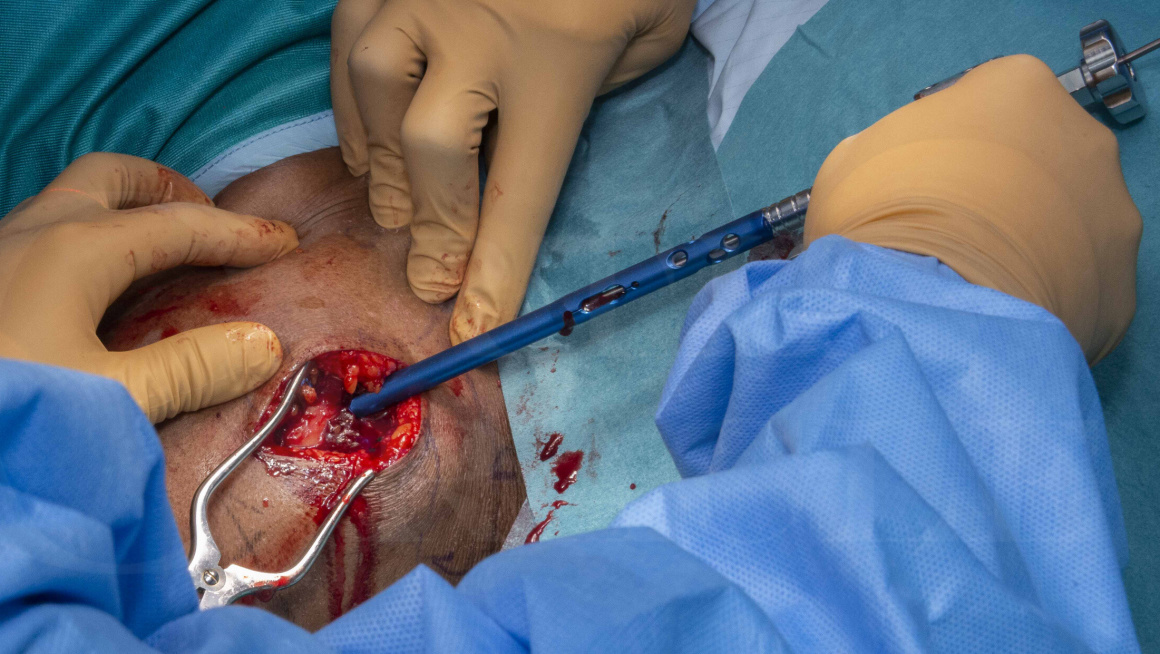Humeral shaft fracture: Nailing with Synthes Multiloc Humeral Nail
Overview

Subscribe to get full access to this operation and the extensive Shoulder & Elbow Surgery Atlas.
Learn the Humeral shaft fracture: Nailing with Synthes Multiloc Humeral Nail surgical technique with step by step instructions on OrthOracle. Our e-learning platform contains high resolution images and a certified CME of the Humeral shaft fracture: Nailing with Synthes Multiloc Humeral Nail surgical procedure.
For humeral shaft fractures, plate fixation remains the commonest method of surgery for those that require operative stabilisation. However there are a few well defined indications for humeral nailing, though in broader terms showed that there seems little difference in union rates or neurologic injury rates when compared to plate fixation (Harkin et al 2017). Surgeons should be aware that damage to the rotator cuff can on occasion result from the approach required for humeral nailing and there is some evidence that nailing using a proximal entry nail is associated with an increased requirement for subsequent secondary shoulder surgery.
Most commonly, humeral nailing is indicated for pathological fractures. Importantly, all these cases are discussed first in a multidisciplinary setting in conjunction with the local bone tumour unit where all options from curative to palliative procedures are considered depending on the underlying pathology. For those that require humeral nailing, the indications include:
For pain relief and stabilisation in the context of palliation to improve quality of life e.g. widespread metastatic cancer. Commonly, these patients are medically frail and benefit from a minimally invasive and less complex procedure.
High risk of non-union in pathological bone where there is, by definition, a low chance of bony healing e.g. in myeloma. The surgery is usually for pain relief and stabilisation of the fracture. This is usually managed in combination with other potential treatments e.g. radiotherapy or chemotherapy.
A high risk of problems with an open wound. When there is a soft tissue component to the lesion that may compromise soft tissue healing, humeral nailing allows surgical stabilisation of fractures with small incisions that bypass the fracture site. Again, this is in the context of non-curative surgery.
Significant risk of intra-operative bleeding from vascular metastases such as metastatic renal cell carcinoma. Lin et al. suggested there was decreased blood loss with intramedullary nailing compared with plating.
Painful impending pathological fractures may also be considered for humeral nailing.
All these indications are dependent on the location of the fracture and whether there is enough bone stock either side of the fracture to accommodate humeral nailing. There has to be enough good bone stock to allow 2 distal locking screws in the humeral shaft as well as in the humeral head.
For non-pathological humeral fractures, my default is to open reduction and internal plate fixation in those fractures where surgery is indicated. However, there can be surgical considerations where a humeral nail may be advantageous over plate fixation, in particular:
Segmental fractures where an very extensile approach is otherwise required to expose and reduce and fix the fracture.
There are also techniques described in the literature for humeral nailing in combined proximal humerus and humeral shaft fractures. Current literature suggests that there is no difference in union rates and complications between plate fixation and humeral nailing. Never the less humeral nailing in this situation has gained interest as it is far less traumatic to the soft tissue envelope, less devitalising to the bone fragments and can be a quicker procedure than open reduction and internal fixation.
The theoretical advantages include load sharing properties of a nail and smaller scars. Intramedullary nailing may be advantageous particularly if there is clinical concern with regard to the soft tissues, in severely osteoporotic bone and in pathological fractures where there is a concern regarding potential bleeding or if there is a soft tissue component. They also allow splintage of the whole humerus if there are skip lesions.
As with any load sharing device a humeral nail potentially allows for earlier mobilisation and loading in comparison to plate fixation. However, in reality, a pragmatic approach is taken with surgical fixation of the humerus, and patients are usually allowed to partially load-bear irrespective of form of fixation if they are struggling to mobilise/function, with either form of fixation.
The Synthes Multiloc nails come in a short and long versions and are side specific . The short nail is 160mm in length and is designed for use in proximal humerus fractures. The long nail ranges from 180mm to 315mm in length and increases in 15mm increments. One key feature is that there are multiple proximal and distal locking options which gives the flexibility to address a variety of different fracture patterns.
The Multiloc screws have blunt tips to minimise the risk of perforation through the humerus and into the glenohumeral joint. The screws can be countersunk to minimise the risk of impingement. There are also options of suture holes in the screws to secure the rotator cuff as well as a secondary locking screw in screws to improve fixation in osteoporotic bone.
Readers will also find of use the following associated OrthOracle instructional techniques:
Humeral fracture: K-wiring of Supracondylar flexion pattern fracture.
Humeral fracture: Fixation of proximal physeal fracture using Synthes Philos plate
Total shoulder replacement: Lima SMR Reverse Shoulder for proximal humeral fracture
Author: Samuel Chan FRCS (Tr & Orth)
Institution: Queen Elizabeth Hospital, Birmingham, UK.
Clinicians should seek clarification on whether any implant demonstrated is licensed for use in their own country.
In the USA contact: fda.gov
In the UK contact: gov.uk
In the EU contact: ema.europa.eu



















